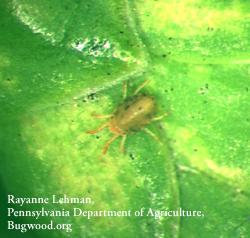It’s bound to happen eventually. You’ll be admiring your houseplant and notice tiny webs. Perhaps your outside shrub just doesn’t look healthy and you see little specks on the leaves. If you don’t figure out the problem, your plant may die…
Spider mites, barely visible to the eye, top the list of the usual suspects. Both the immature form and the adult spider mites suck plant sap from both indoor and outdoor plants. As their numbers increase, the mites spin protective fine webbing on the leaves. And, as their populations increase quickly in hot and dry environments, it’s easy to mistake the webs as dust.
Wondering how to verify if you have spider mites? Take several suspicious leaves and shake them over some white paper. Specks will fall on the paper. If they’re moving, they’re spider mites. The most commonly found spider mite is the “two-spotted” spider mite, getting its name from the two dark spots on its back.
Because spider mites are so small, but cause so much damage, it is important to closely check plants prior to purchase. It would be prudent to quarantine new plants, but for most of us, this would be difficult.
Luckily, spider mites are relatively easy to control if the infestation is not heavy. If it is heavy, it is probably best to discard the plant.
This list shows a variety of controls, in case you do spot spider mites:
- Use an insecticidal soap to thoroughly wash the upper and lower sides of the leaves and remove webs. Alternatively, wash the plant in a solution of 1-2 teaspoons of dishwashing liquid soap (not dishwasher soap or laundry detergent) in a gallon of water. Weekly repeated washings will kill emerging larvae and nymphs over time.
- Miticide sprays and washes contain specialized chemicals to kill and interrupt the life cycle. Many contain Bifenthrin as an ingredient.
- Horticultural oils smother spider mites. This is an especially effective control on outdoor plantings.
- Systemic insecticides, applied in granular or liquid form on the soil, dissolve in water for absorption by the plant roots. The mites die when they suck the plant juices. This method takes longer but provides long lasting control.
- Predators of spider mites include commercially available phytoseiid mites and lady beetles, big-eyed bugs and predatory thrips.
After you’ve eliminated the spider mites, take precautions to ensure they don’t return. Remember to inspect incoming new plants or quarantine, if possible. A semi-annual houseplant shower is good for inspection, removal of dust and other pollutants. Remember, spider mites thrive in hot and dry environments. For houseplants, unless the plant requires these conditions, reduce the heat by relocating and increase air humidity by spraying or placing over a tray of water and pebbles. Affected outdoor plants may be sprayed or shaded with a standing structure.



